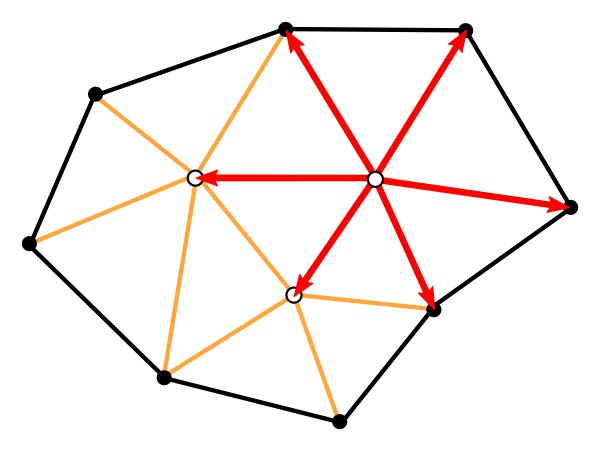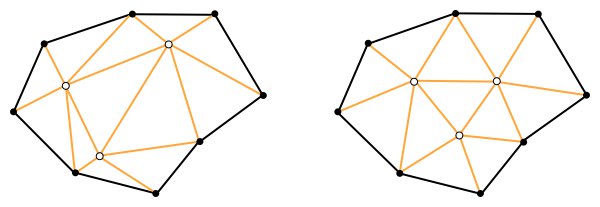Imagine a rubber band stretched out between two points $p,q \in \mathbb{R}^n$. We assume that the rubber band is an ideal one, which means that it would really contract to a point when released and that the energy stored in the rubber satisfies Hooke’s law of elasticity perfectly. The the elastic energy of the stretched band is
$\displaystyle E=\frac{c}{2}|q-p|^2$
Here $c$ is some constant. It is called the spring constant, since we could also imagine springs instead of rubber bands. For the moment we will assume $c=1$. If we keep $q$ fixed and try to move $p$ we experience a force $F$ at $p$ which is minus the gradient of the energy:
$\displaystyle F = -\textrm{grad }(p\mapsto E(p)=\frac{1}{2}|q-p|^2) = q-p$.
Suppose now we have a discrete surface and a map
$f: V \rightarrow \mathbb{R}^n$
from the set of vertices into $\mathbb{R}^n$. Think of the edges of the graph as realized by rubber bands trying to pull the points $f(\textrm{start}(e))$ and $f(\textrm{end}(e))$ together. Then the total energy stored in the configuration $f$ will be
$\displaystyle E(f) = \frac{1}{2} \sum_{e \in \hat{E}} |f(\textrm{end}(e))-f(\textrm{start}(e))|^2 = \frac{1}{2} \sum_{e \in \hat{E}} |df(e)|^2$.
It is enough to know this energy in the case $n=1$ (the whole graph is stretched out on a line) since in the general case the energy is just the sum of the energies of the $n$ different components of $f$. In the 1-dimensional case it is clear that we basically are dealing with a euclidean scalar product $\langle \!\langle \,,\rangle \!\rangle$ on the vector space $\Omega_1(M)$ whose norm is given by
$||\omega||^2=\sum_{e \in \hat{E}} |\omega(e)|^2$.
With this notation we then have
$E(f) =\frac{1}{2}||df||^2$
and it is clear how to extend these definitions to the case of $\mathbb{R}^n$-valued 1-forms and functions. We call $E(f)$ the combinatorial Dirichlet energy of $f$.
Imagine that we fix some vertices (maybe those on the boundary) and let the interior vertices find positions such that the stretching energy $E$ achieves a minimum value.
In such an equilibrium position the forces at each vertex have to balance out, i.e. their they must sum up to zero.
 These forces are exactly the values of the 1-form $df$ on the outgoing edges at the vertex. Thus it seems that the mentioned sum is just the value at the vertex of the dual 1-form obtained by re-interpreting the values of the 1-form $df$ on edges as defining a dual 1-form, call it $*df$.
These forces are exactly the values of the 1-form $df$ on the outgoing edges at the vertex. Thus it seems that the mentioned sum is just the value at the vertex of the dual 1-form obtained by re-interpreting the values of the 1-form $df$ on edges as defining a dual 1-form, call it $*df$.
How do we get there? First note that we can use the euclidean scalar product to define a vector space isomorphism
$*:\Omega_1(M) \rightarrow \Omega_1(M)^* = \Omega_1(M^*)$.
$\displaystyle \langle *\omega, \eta \rangle = \langle \!\langle \omega, \eta \rangle \!\rangle$.
When we work out what this means we arrive at
$(*\omega)(e):=\omega(e)$.
Now the force balancing condition can be formulated as
$\partial*df=0$.

